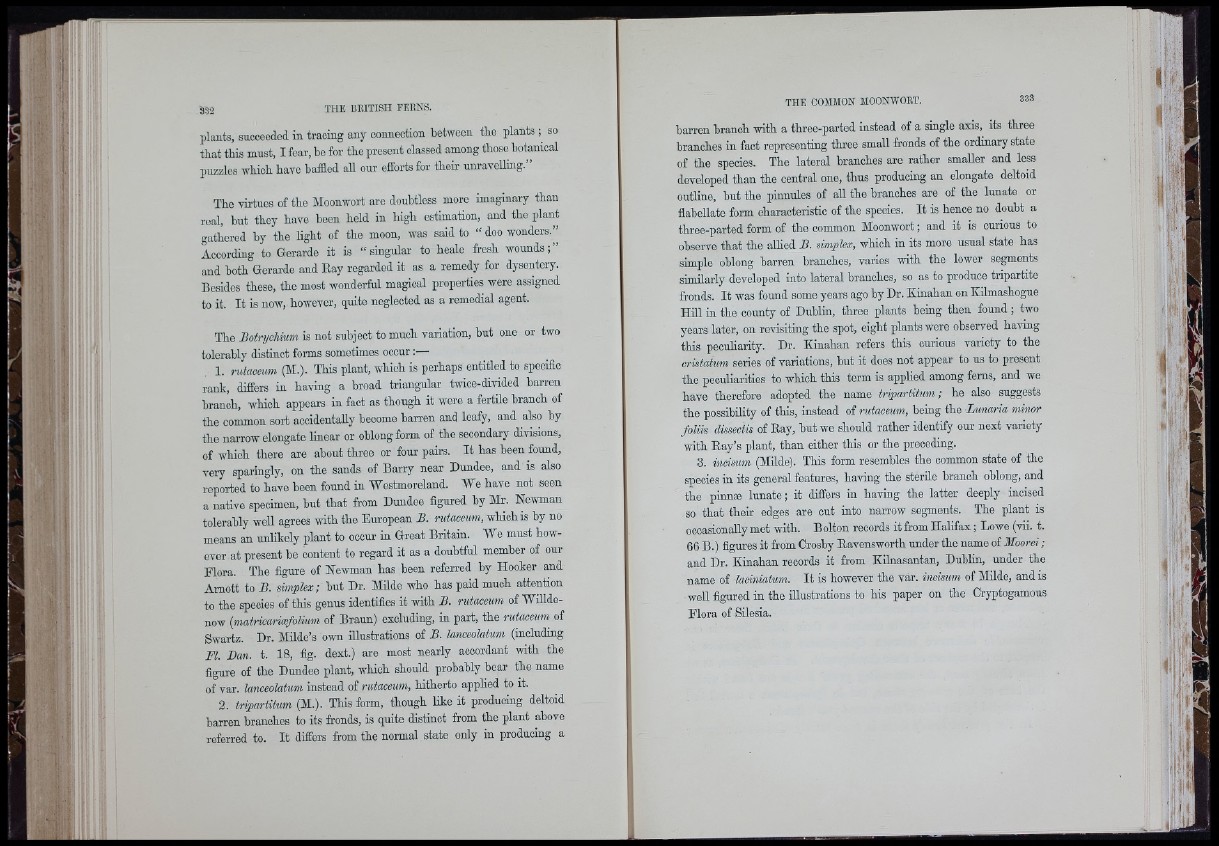
lie : |]3
plants, succeeded in tracing any connection between tbo plants [ so
tbat this must, I fear, ho for the present classed among those botanical
puzzles which have baffled aU our efforts for their unraYclling.”
Tho virtues of tho Moonwort are doubtless more imaginary than
real, but they have been held in high estimation, and the plant
gathered by the light of the moon, was said to “ doo wonders.”
According to Gerarde it is “ singular to heale fresh wounds;”
and both Gerarde and Eay regarded it as a remedy for dysentery.
Besides these, the most wonderful magical properties were assigned
to it. It is now, however, quite neglected as a remedial agent.
The Botrychium is not subject to much variation, but one or two
tolerably distinot forms sometimes occur:—
1. rutaceum (M.). This plant, which is perhaps entitled to specific
rank, differs in having a broad triangular twioe-dividcd barren
branch, which appears in fact as though it were a fertUe branch of
the common sort accidentally become barren and leafy, and also by
the narrow elongate hnear or oblong form of the secondary divisions,
of which there are about three or four pairs. It has been found,
very sparingly, on the sands of Barry near Dundee, and is also
reported to have been found in Westmoreland. We have not seen
a native specimen, bnt that from Dundee figured by Mn Newman
tolerably weU agrees with the European B. rutaceum, which is by no
means an unlikely plant to occur in Great Britain. We must however
at present be content to regard it as a doubtful member of our
Flora. The figure of Newman has been referred by Hooker and
Arnott to B. simplex; hut Dr. MUde who has paid much attention
to the species of this genus identifies it with B. rutaceum of WUlde-
now {matricarimfolium of Braun) excluding, in part, the rutaceum of
Swartz. Dr. MUde’s own iUustrations of B. lanceoMum (including
Fl. Ban. t. 18, fig. dext.) are most nearly accordant with the
figure of the Dundee plant, which should prohahly boar the name
of var. lanceoMum instead of rutaceum, hitherto applied to it.
2. tripartitum (M.). This form, though like it producing deltoid
barren branches to its fronds, is quite distinct from the plant above
referred to. It differs from the normal state only in producing a
barren branch with a three-parted instead of a single axis, its three
branches in fact representing three small fronds of the ordinary state
of the species. The lateral branches aro rather smaUer and less
developed than the central one, thus producing an elongate deltoid
outline, hut the pinnules of all the branches are of the lunate or
flabellate form characteristic of the species. It is hence no donht a
three-parted form of the common Moonwort ; and it is curious to
observe that the aUied B. simplex, which in its more usual state has
simple ohlong barren branches, varies with the lower segments
similarly developed into lateral branches, so as to produce tripartite
fronds. It was found some years ago by Dr. Kinahan on Kilmashogue
HUl in the county of DuhUn, three plants being then found ; two
years later, on revisiting the spot, eight plants were observed having
this peculiarity. Dr. Kinahan refers this curious variety to the
cristatum series of variations, but it does not appear to us to present
the peculiarities to which this term is applied among ferns, aud we
have therefore adopted the name tripartitum; he also suggests
the possibility of this, instead of rutaceum, being the Lunaria minor
foliis dissectis of Eay, hut we should rather identify our next variety
with Eay’s plant, than either this or the preceding.
3. incisum (Milde). This form resembles the common state of the
species iu its general features, having the sterile branch oblong, and
the pinnæ lunate; it differs in having the latter deeply incised
so that their edges are out into narrow segments. The plant is
oooasionally met with. Bolton records it from Halifax ; Lowe (vii. t.
66 B.) figures it from Crosby Eavensworth under the name of Moorei ;
and Dr. Kinahan records it from Künasantan, Dublin, under the
name of laciniatum. It is however the var. incisum of MMe, and is
well figured in the iUustrations to his paper on the Cryptogamous
Flora of SUesia.
iíM
m '’:-
. m
, i'
't'1
'4 iisl
ff"
ff ff
] '
■Ii
*■-'1
j I I
i I.Î
i ff
i :l|fi lliff